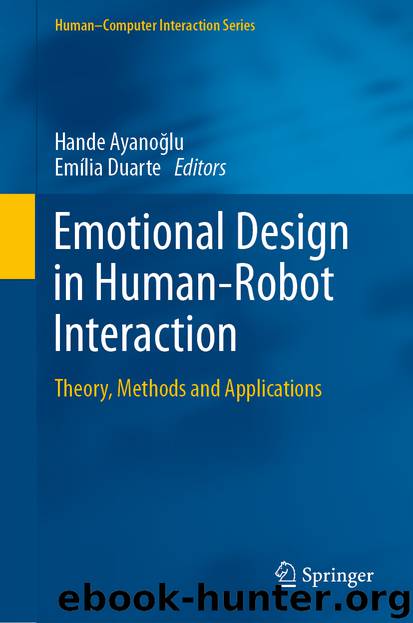Emotional Design in Human-Robot Interaction by Hande Ayanoğlu & Emília Duarte

Author:Hande Ayanoğlu & Emília Duarte
Language: eng
Format: epub
ISBN: 9783319967226
Publisher: Springer International Publishing
Petisca et al. (2015) highlight that “more social and emotional behavior may lead to poorer perceptions of a social robot.” In a similar study, Kennedy et al. (2015) also showed how embedding social behavior to robots may negatively affect child learning. In their study, Petisca et al. (2015) used an autonomous robot that played a game against a participant while expressing some social behaviors. They wanted to see whether the emotional sharing of the robot affected how its users perceived it. To the surprise of the researchers, and contrary to their hypothesis, they found that in the non-sharing condition, participants rated the robot more “conscious, lifelike, and nice.” At the end of their paper, they highlight the importance of being cautious when embedding social behaviors in HRI; and claim that more research is needed to understand in which contexts the emotional sharing of the robot provides it with better social capabilities and in which such sharing should be avoided (Petisca et al. 2015).
Some researchers argue that by allowing the robot to show attention, care, and concern for the user (Turkle 2006), as well as being able to engage in genuine, meaningful interactions, socially assistive robots can be useful as therapeutic tools (Shukla et al. 2015). Others, however, suggest that the emotional sharing from the robot to the user does not necessarily imply feeling closer to it (Goetz et al. 2003). This context-dependent division may suggest that there could be a “purpose limitation.” In law, purpose limitation refers to one of the principles relating to the processing of personal data. It states that a data controller has to collect data for specified, explicit, and legitimate purposes and that they cannot use it for other purposes. In this case, however, it would relate more to the establishment of a limitation in the contexts where emotions are used. For instance, and based on the given examples, the use of emotions in therapeutic contexts could improve the interaction of the users.
Still, the use of emotions (personalization or emotional adaptation) raises other types of questions concerning how appropriate the use of emotional data from patients is under certain clinical conditions. How error-tolerant should the technologies used for the detection of the mood and emotional state of the users be? What lines should the industry not cross? Knowing the impacts, benefits, and limitations of the use of emotions in HRI is essential to understand what safeguards policymakers need to devise to ensure a human-robot safe interaction.b.The lack of standardized procedures and guidelines impedes the establishment of a clear safeguard baseline for safe emotional human-robot interactions.
Download
This site does not store any files on its server. We only index and link to content provided by other sites. Please contact the content providers to delete copyright contents if any and email us, we'll remove relevant links or contents immediately.
Kathy Andrews Collection by Kathy Andrews(11683)
The remains of the day by Kazuo Ishiguro(8751)
Paper Towns by Green John(5026)
Spare by Prince Harry The Duke of Sussex(4999)
The Body: A Guide for Occupants by Bill Bryson(4889)
Industrial Automation from Scratch: A hands-on guide to using sensors, actuators, PLCs, HMIs, and SCADA to automate industrial processes by Olushola Akande(4851)
Machine Learning at Scale with H2O by Gregory Keys | David Whiting(3976)
Be in a Treehouse by Pete Nelson(3878)
Harry Potter and the Goblet Of Fire by J.K. Rowling(3743)
Never by Ken Follett(3708)
Goodbye Paradise(3668)
Into Thin Air by Jon Krakauer(3264)
The Remains of the Day by Kazuo Ishiguro(3256)
The Cellar by Natasha Preston(3222)
The Genius of Japanese Carpentry by Azby Brown(3194)
Fairy Tale by Stephen King(3159)
120 Days of Sodom by Marquis de Sade(3120)
Drawing Shortcuts: Developing Quick Drawing Skills Using Today's Technology by Leggitt Jim(2962)
The Man Who Died Twice by Richard Osman(2959)
